Chapter.2 -Beginning from the burnt fields(1945-1954)-
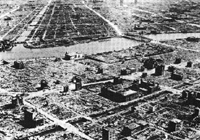
Burnt fields in Tokyo (1945)
To look back on the reconstruction of Akihabara after the war, it is necessary to look back on the history of the Showa 20s.
First, the keywords that look back on the flow of the Japanese economy as a whole are:
(1)Switching to a new yen to control inflation(February 1946)
(2)Occurrence of deflationary economy due to Dodge Line and Shaup tax system (April 1949)
(3)Special Demand Economy Due to Korean Upheaval (June 1950-July 1953)
And what had a great influence on the situation surrounding Akihabara was:
(4)Prosperity of street vendors due to popularity of assembled radio
(5)Example of stall abolition by GHQ (Occupation Army) (September 1949)
(6)Commercial radio stations started broadcasting (1951)
(7)1953 “First Year of Home Appliances”-Start of TV broadcasting-
These are the 7 points.
Overall flow of Japanese economy in Showa 20s
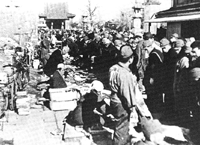 |
| Black market right after the end of the war (1946) |
At the end of the war on August 15, 1945, Tokyo was truly a burnt field.
However, people cannot live without eating. In the suburbs of Tokyo, people could sell anything as long as they could buy groceries and daily necessities. A so-called black market occurred around stations with many passengers getting on and off the national railways, such as Shimbashi/Shinjuku/Shibuya, and Kanda/Ueno/Akihabara.
(1)Switching to a new yen to control inflation(February 1946)
While the war is over and the number of people returning from the battlefield is increasing and supplies are becoming increasingly scarce, the end of the war, such as 7 million military personnel, military retirement payments and temporary military payments to military factories The total amount reached 26.6 billion yen in just three months. This amount is almost the same as the extraordinary military expenditure in 1943 (Showa 18), and naturally there will be no inflation of goods, but if only the currency increases, inflation will naturally proceed rapidly. Prices increased fivefold from 1945 (Showa 20) to 1946 (Showa 21). Such extreme inflation further exacerbated the public’s anxiety and repeated a vicious cycle of buying supplies. In such a situation, the government deposits all “old banknotes (5 yen or more)” at financial institutions and makes them into closed deposits. From March 1946 (Showa 21), the household head is 300 yen and the family is 100 yen. Only for new coins, you can withdraw. In other words, they are the “Financial Emergency Measures Order” and the “Bank of Japan Deposit Order”, and the so-called “new yen switching”.Furthermore, the “Price Control Ordinance” was promulgated and implemented, and the new price system (3.3 price system) was promulgated. With this series of measures, the demand restraint policy was once successful, and inflation calmed down for a while.
(2)Occurrence of deflationary economy due to Dodge Line and Shaup tax system (April 1949)
GHQ (General Commander of the Occupation Army) at that time announced “9 principles of economic stability” in an attempt to make a full-scale improvement in the inflationary Japanese economy. In February 1949 (Showa 24), the Detroit Bank president, Dodge Minister and GHQ Advisor, visited Japan and made a recommendation on Japan’s series of fiscal and monetary policies. In accordance with this recommendation, a strong stability policy was implemented from 1949. This is the so-called “Dodge Line”.
The dodge line is based on the following three points.
(A) Balance of national budget (balance between tax revenue and fiscal expenditure)
(B) Single exchange rate ($1 = 360 yen) and free trade
(C) Reform of the US aid system to Japan (the so-called “cutting off two stilts” and the termination of domestic supply)
As a result, although it was effective in curbing inflation, it began to show signs of extreme financial pressure, bankruptcy of small and medium-sized enterprises, increased unemployment, and a deflationary economy.
In addition, the tax reform based on the “Shoop Recommendation” aimed at “increasing tax revenue” caused a rapid increase in taxation on corporations, pressured corporate management, and many companies went bankrupt.
(3)Special Demand Economy Due to Korean Upheaval (June 1950-July 1953)
It was the Korean uprising that began in June 1950 (Showa 25) that saved such troubles. The unfortunate incident that happened in the neighboring country made Japan a military base, created huge special demand for goods and services, and increased exports sharply. The industrial world revived, and the electrical product wholesale business around Akihabara and the electrical construction material industry also rapidly increased in inventory, soaring all the products, and in some cases, many times, suddenly booming.
Japan in the Showa 20s had a boom and bust with the above three turning points.
Changes surrounding Akihabara in the Showa 20s
In addition to Hirose Musen, Yamagiwa Denki Shokai, Takaoka Denki, Nakagawa Musen, which had stores before the war, Imamura Denki, Ishimaru Denki, Shimura Musen, Taniguchi Shoten, Asahi Musen Denki, Nakaura Denki, Minami Musen, Yamabishi Denki, etc. There was a store along Chuo-dori, and there were Kano Musen near Manseibashi, Mansei Shokai, Nakajima Musen and Kaneda Shokai on Sudacho Corner. Also, in 1948(Showa 23), Kakuta Radio established its current location, and Sintoku Denki and Onoden also opened stores. The current Akihabara groundwork was built rapidly in the short postwar period.
The background of the large number of electric appliances dealers gathering in Akihabara is that Hirose Shokai has a network in the region as a general wholesaler, and it is crowded with retailers/general wholesalers/secondary wholesalers who come from the regions to purchase, and Akihabara is cheap. It was said that this was due to the widespread advertisement. Also, not only JNR but “Toden” was an important foot of the common people at that time, and Akihabara was a very convenient place to use the Toden. Manseibashi was the starting point for “Yanagishima (Mukojima)”, and turned back at Sudacho for Mukojima, and passed Nihonbashi from Manjibashi from Oji to Shinagawa. Also, the train bound for Shinjuku was out of Manseibashi. This good access to the JNR/Toden is probably the reason for the prosperity of electronic merchants in Akihabara.
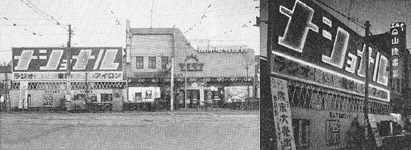
Left: Yamagiwa Denki head office (1950) Right: Yamagiwa Denki year-end sale (1951)
(4)Prosperity of street vendors due to popularity of assembled radio
On the other hand, among the “street vendors” that emerged from the post-war turmoil, vacuum tubes sold well between the Ogawa town and the street vendors in the neighborhood of Kandasuda town, forming the “electric town” of street vendors. It happened that a student at a nearby Denki Technical College (now Tokyo Denki University) did a part-time job to assemble and sell a radio, but the radio popularity at that time made it explosive. Looking at this, other street vendors also turned goods into vacuum tubes, and there are also street vendors who are familiar with electricity. Generally, among the street vendors that mainly sell fiber / miscellaneous goods, only street vendors from Kanda Ogawamachi to Kandasuda Town neighborhood are available. Said that of the 120 stalls around 1950 (Showa 25), about 50 were electric appliances dealers. It started to take on the appearance of an “electric town.”
(5)Example of abolition of stalls by GHQ(September 1949)
As the post-war turmoil subsided, GHQ (Occupation Forces General Headquarters) thought that it was necessary to enhance various social infrastructures in order to rebuild Japan, in order to lay and widen major roads. In 1949, the stall abolition order was enforced, ordering the relocation of street vendors.
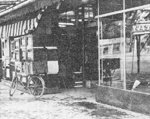 |
| Early 1945’s scenery |
Street vendors demanded a covered alternative site, as the abolition of stalls would immediately lead to hardships. The Tokyo Metropolitan Government, in cooperation with the Japanese National Railways, provided an alternative site from Kanda Ogawamachi to street vendors in the Kanda Sudacho area under the guard of Akihabara Station, and in 1949 a radio store opened directly under the elevated line. The following year, the movement of street vendors began in 1950, and the radio center opened in union units, the Tokyo Radio Department Store next to the elevated line across the street, the radio garden at the foot of Manseibashi the following year, and a two-story building next to the center. The Akihabara Radio Garden was built in a nagaya style, and the eaves were hung.
In this way, “Akihabara”, which consists of the current Chuo-dori and the electric stores around the Electric Town Exit of JR Akihabara Station, was completed.
(6)Commercial radio station broadcasting started (1951)
Akihabara, which was formed after the war in this way, will be blessed with some big opportunities as it grows further rapidly.
 |
| Early 1945’s scenery |
In addition to the special demand caused by the Korean War mentioned above, the growing demand for radio before and after the war also contributed greatly to the prosperity of Akihabara. During the post-war turmoil, the radio assembly boom first occurred. Radio, which was a valuable means of obtaining information on the war situation during the war, became a means of obtaining entertainment and information along with the defeat, and the demand for replacement of radio during the war also overlapped, and it sold well. However, the price of the finished radio at that time was two to three times the total price of the assembled parts, and many people bought the assembled radio. In addition, the 30% excise tax on finished radio, which was a luxury item due to the tax change in 1949, was abolished, the price difference narrowed, and when private radio broadcasting started in 1951, interference was severe in the assembly type. , It will change to a finished product manufacturer’s product called a super receiver, but all radios were selling explosively in Akihabara. Even now, there are many shops / buildings in Akihabara that retain the name of radio because they were established and named at that time.
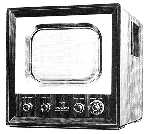 |
| 1951 / Hayakawa Electric (Sharp) |
(7)1953 “First Year of Home Appliances” -Start of TV Broadcasting-
As the boom continues due to the special demand of the Korean War, the next step of development is approaching. It is the start of television broadcasting. Among the “black and white TVs / electric refrigerators / electric washing machines” that were said to be “three sacred treasures” in the early 1955’s, the sprouting of the explosive hits of TVs and washing machines began in 1953. This year is called the “first year of home appliances” in the home appliances industry, and when comparing the number of shipments with 1952,
Radio: 1.08 million units → 1.4 million units (29% increase)
Fans: 290,000 units → 430,000 units (48% increase)
Refrigerator: 3600 units → 7500 units (108% increase)
Washing machines: 15,100 units → 104,700 units (up 593%)
Iron: 770,000 units → 910,000 units (up 18%)
… And made me feel a leap in the Showa 30’s.
 |
| 1953 / Sanyo SW-53: Jet type No. 1 28,500yen |
Until around 1951, there were only record players, desk lamps, irons, electric fans, and electric stoves other than radios, but in 1953 Hayakawa Electric (now Sharp) sold a 14-inch black-and-white TV for 175,000 yen. Sold (14,384 units sold in the first year).
Similarly, in August 1953, Sanyo Electric released a square jet-type washing machine for 28,500 yen (at that time, the domestic round-type stirring type was over 50,000 yen).
Both became big hits, and many manufacturers began to enter the so-called “home appliances” genre.
Akihabara, which started selling radio parts and electrical construction materials during the pre-war and post-war turmoil, has entered a period of leap in sales of TVs and washing machines, and has grown due to the retail sales of wholesalers and the expansion of stores. It will be the 1955’s.
References:
“History of Chiyoda Ward (published by Chiyoda Ward)”
“The Akihabara (Nikkei Sangyo Shimbun)”
“Yamagiwa 60 Years of History”
“Laox 50 Years Corporate History”
